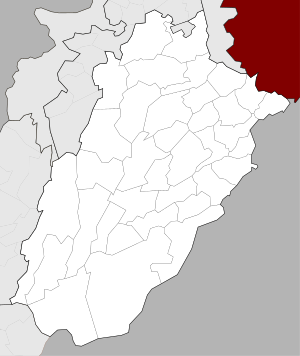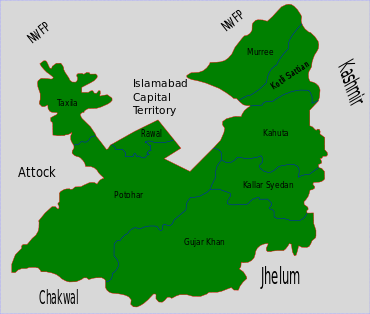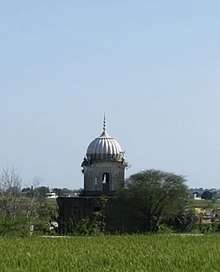Kallar Syedan
| Kallar Syedan کلر سیداں | |
|---|---|
| City | |
 Kallar Syedan  Kallar Syedan | |
| Coordinates: 33°24′52″N 73°22′43″E / 33.41444°N 73.37861°ECoordinates: 33°24′52″N 73°22′43″E / 33.41444°N 73.37861°E | |
| Country | Pakistan |
| Region | Punjab |
| District | Rawalpindi District |
| Tehsil | Kallar Syedan Tehsil |
| Capital City | Kallar Syedan |
| Towns | 15 |
| Union councils | 11 |
| Government | |
| • Mayor | Sheikh Abdul Qadoos |
| Elevation | 520 m (1,710 ft) |
| Time zone | UTC+5 (PST) |
| Area code(s) | 051 |
Kallar Syedan (Punjabi/Urdu: کلر سیداں) is a city in Punjab, Pakistan and the headquarters of the Kallar Syedan Tehsil.
History

Records of the town's existence go back 1200 years .
The town rose to prominence during the Sikh rule that left a number of imprints in the form of havelis and gurdwaras, while small fortresses dotted the whole of Rawalpindi district. During Sikh rule, the Hindus constructed many temples in Rawalpindi. Krishna Temple, a Hindu temple overlooking a Nullah at Kallar Syedan, dates back to Sikh period.[1] Bedi Mahal was built by Baba Khem Singh Bedi in the later half of the 19th century;[2] it was turned into a high school Government Boys High School, Kallar Syedan) after the division of India and Pakistan.[3]
Etymology
As for as the name Kallar Syedan, there are three theories:
- Kallar came from Killo Shah, name of a respected man.
- There were two famous brothers living in the area: Bela Rai and Killo Rai. Bewal was named after Bela Rai and Kallar was named after Killo Rai.
- Kallar was wasteland a jungle and all the wells in the area were (kharra), a term used for "rough water". Even now the wells in tehsil Kallar Syedan are mostly kharra, so that is how Kallar came out of kharra term.
Population
The principal clans of Kallar Syedan are the Malik Awan, Qureshis, Gakhar, Gujar, Mughals, Sayyid, Rajputs (Jasyal Kanyals, Hashmis, Choudhury Rajputs). Most own various shops, while others are farmers. Many go abroad for a living, especially to the United Kingdom.
Transport
Road
Kallar Syedan is located on the N-38 Kallar Syedan Road from Rawalpindi To Azad Kashmir. Kallar Syedan Road links from the east of the city to the nearby town Choha Khalsa and Dadyal Tehsil Of Azad Kashmir Kallar Syedan Byepass is a new build Road South Sid of city.[4] For Traffic go Pass Kallar Syedan City For Dadyal Tehsil Of Azad Kashmir and They are also Road Go to Gujar Khan and Kahuta many other minor roads linking the villages and towns of the region to the city.
Bus and minibus
Local services also provide extensive bus and Van routes around the local towns, and smaller shuttles go around the villages in the surrounding area. There are also services to Rawalpindi,[5] Islamabad,[6] Azad Kashmir, Kahuta, Gujar Khan, and Lahore.
Local Auto-Rickshaw drivers also provide transport for people in and around the city.

Places of interest
Schools and colleges
- Punjab College Kallar Syedan
- Super wings college Kallar Syedan
- Government Degree College for Boys Kallar Syedan
- Shaheen Public School and college
- Government Degree College For Women
- Government Boys High School Kallar Syedan
- Allied School Kallar Saiyadan Campus
- Fauji Foundation Model School Kallar Syedan
Notable people
- Tikka Khan, Army Chief of Staff (1972–1976), Governor of East Pakistan (1971), Governor of Punjab (1988–1990)
- Abdul Aziz Mirza, Chief of Naval Staff, ambassador to Saudi Arabia.
- Sardar Tariq Masood, Justice Supreme Court of Pakistan.
References
- ↑ "Kallar Syedan's Krishna temple: Precious heritage in ruins". Free Hindi ebooks. 2015-01-01. Retrieved 2018-06-01.
- ↑ "Mardana Mian Mir descendants". www.info-sikh.com. Retrieved 2018-06-01.
- ↑ schoolinglog.com. "Government Boys High School KALAR SYEDAN, KALLAR SYEDAN, KALLAR SYEDAN". www.schoolinglog.com. Retrieved 2018-06-01.
- ↑ "Kallar Syedan Bypass, Punjab". pakistan-streets.openalfa.com.
- ↑ "Raja Bazaar-Kallar Syedan transport service allegedly overcharging commuters".
- ↑ "Transporters fleece commuters". 10 March 2003.